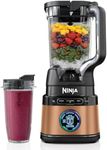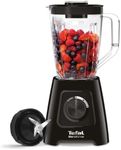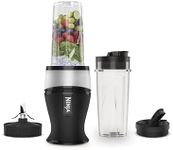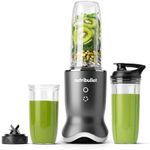Buying Guide for the Best Smoothies Makers
Choosing the right smoothie maker can make a big difference in your daily routine, especially if you love starting your day with a healthy, delicious smoothie. When selecting a smoothie maker, it's important to consider several key specifications to ensure you get the best fit for your needs. Understanding these specs will help you make an informed decision and enjoy your smoothie-making experience to the fullest.Power (Wattage)Power, measured in watts, determines how efficiently and quickly a smoothie maker can blend ingredients. Higher wattage means more powerful blending, which is especially important for crushing ice and blending tough ingredients like frozen fruits and vegetables. For basic smoothies with soft fruits, a lower wattage (300-500 watts) may suffice. For more versatility and smoother blends, especially if you plan to use ice or hard ingredients, look for a smoothie maker with 600 watts or more.
CapacityCapacity refers to the volume of the blending jar, usually measured in liters or ounces. This is important because it determines how much smoothie you can make in one go. If you’re making smoothies just for yourself, a smaller capacity (around 16-24 ounces) might be sufficient. For families or if you like to prepare multiple servings at once, look for a larger capacity (32 ounces or more). Consider your daily smoothie needs to choose the right capacity.
BladesThe quality and design of the blades are crucial for effective blending. Stainless steel blades are durable and resistant to rust, making them a good choice. Some smoothie makers have multiple blades or specially designed blades for better performance. If you plan to blend a variety of ingredients, including ice and nuts, look for smoothie makers with strong, sharp blades. For basic fruit smoothies, standard blades will do the job.
Speed SettingsSpeed settings allow you to control the blending process. More speed options give you greater control over the texture of your smoothie. Basic models may have just one or two speeds, which can be sufficient for simple smoothies. More advanced models offer multiple speed settings and even pre-programmed functions for different types of blends. If you like experimenting with different textures or ingredients, opt for a smoothie maker with multiple speed settings.
Ease of CleaningCleaning your smoothie maker can be a hassle, so it's important to consider how easy it is to clean. Look for models with dishwasher-safe parts or those that can be easily disassembled for thorough cleaning. Some smoothie makers have self-cleaning functions, which can save you time and effort. If you plan to use your smoothie maker frequently, ease of cleaning should be a top priority to ensure it remains hygienic and ready for use.
PortabilityPortability is a key factor if you want to take your smoothie maker on the go or if you have limited kitchen space. Some models come with travel cups or are designed to be compact and lightweight. If you need a smoothie maker for use at work, the gym, or while traveling, look for a portable model with features like a secure lid and easy-to-carry design. For home use, portability might be less of a concern, but a compact design can still save valuable counter space.
Noise LevelBlending can be noisy, and if you’re sensitive to noise or live in a shared space, this is an important consideration. Some smoothie makers are designed to operate more quietly than others. If noise is a concern, look for models that advertise low noise levels or have noise-reducing features. Keep in mind that more powerful blenders tend to be louder, so you may need to balance power and noise level based on your preferences.















